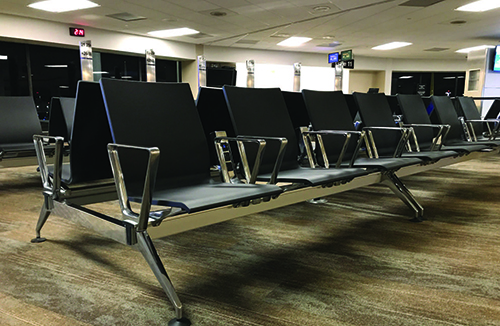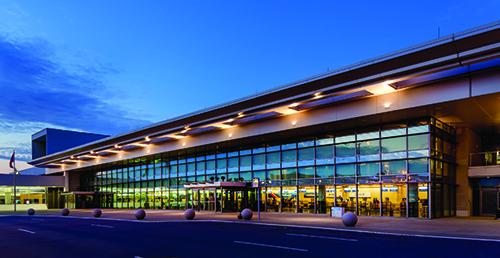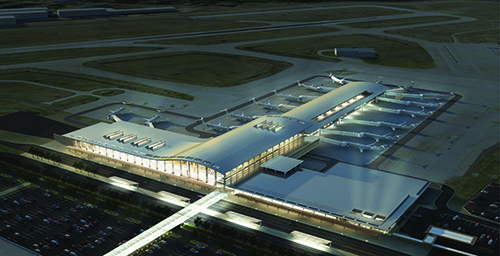Clinton Nat’l Focuses on Passenger Comfort in Latest Round of Terminal Improvements

 Ronald Mathieu believes in three things regarding infrastructure projects: listening to customers, doing it right the first time and preparing for the future. As executive director of Bill and Hillary Clinton National (LIT), Mathieu stayed true to each of those core principals while overseeing $25 million of recent enhancements throughout the concourse of the Little Rock, AR, airport.
Ronald Mathieu believes in three things regarding infrastructure projects: listening to customers, doing it right the first time and preparing for the future. As executive director of Bill and Hillary Clinton National (LIT), Mathieu stayed true to each of those core principals while overseeing $25 million of recent enhancements throughout the concourse of the Little Rock, AR, airport.
Specific improvements include free Wi-Fi throughout the terminal, power/charging outlets in every seat and upgraded restrooms. The changes are part of a decade-long effort to modernize facilities in incremental steps. The development strategy was designed to allow the airport time to strengthen its financial position in between investments and has helped LIT become one of the few airports in North America that is 100% debt-free.
“We understand that people have a choice,” says Mathieu. “They can come to us, they can go to another airport or they can drive. We have to give our customers more reasons to not only fly, but more reasons to fly out of Little Rock. It’s a competitive market, and we need to understand our customers’ needs. It’s important to not only meet the expectations of our customers, but to exceed those expectations every single day.”
 facts&figures Project: Concourse Improvements Location: Bill & Hillary Clinton Airport–Little Rock, AR Cost: $25 million Primary Improvements: Free Wi-Fi, power in every seat, upgraded restrooms Architect: Alliiance, in association with Polk Stanley Wilcox & Woods Group Architects Seating: Vitra Wi-Fi: Aruba Customer Satisfaction Surveys: Phoenix Marketing Int’l Boarding Bridges: JBT AeroTech Data Supplier for Flight Info Display System: Com-Net Parking Guidance System: Carlo Gavazzi Revenue Control System: DESIGNA IQ Technology for Waiting Lines: SITA Carpeting: Shaw Flight Info Display System: NEC; LG Digital Antenna System: Verizon Wireless Airline Podiums: Beard Breeding Millwork Paging System: ComNet Of Note: Individual projects follow a unified vision so changes executed over many years remain cohesive |
Passenger Amenities Take Priority
All of the improvements made in the past year were geared at providing more “creature comforts” for passengers, notes Mathieu. Previously, the airport concentrated on structural changes: expanding the ticketing lobby, moving baggage screening machines behind ticketing counters and expanding the security checkpoint. After nearly $70 million of improvements were completed in 2013, airport officials originally planned to stop and regain some financial footing before moving forward with additional improvements.
Then a weak economy took hold and passenger loads did not increase as expected. “We were planning to build a new concourse and baggage claim before our passenger count dropped, but decided to move forward with renovating our current concourse instead,” explains Mathieu.
About the same time, the airport hired a marketing research firm to help gauge customer experiences and preferences. Phoenix Marketing International conducted weekly on-site passenger surveys and found LIT’s satisfaction numbers to be in the mid-80s—a figure that concerned Mathieu. “Now, we have a 98% overall customer satisfaction level, whereas nationally, the average airport customer satisfaction level still sits in the mid-80s,” he reports.
Having third-party personnel interview passengers rather than LIT employees secures “true feedback” and provides the airport ideas about what improvements are needed, he says. “What we learned in this process is that it doesn’t matter what you think, it only matters what the customer thinks. At the end of the day, we serve the community.”
Power to the People
Once Mathieu and his staff learned what customers were thinking, they knew how to proceed. No more cords on the floor or passengers battling over power outlets and USB charging stations at LIT. The airport installed more than 800 power-equipped MedaGate seats from Vitra. “We have power in every seat—not only USB, but also AC power,” he comments. “And it’s a smart USB, so it knows if it is a 2.5-amp phone or a 5-amp iPad that needs to be charged, and it adjusts automatically.”
 The new seats are made of recyclable and die cast aluminum to support the airport’s sustainability goals, and are arranged in five- and six-seat configurations throughout the terminal. “Typically, in the past, you had an arm rest and seat, and arm rest and seat,” says Hendrik Woywod, a Vitra sales specialist. “Little Rock selected a slightly different configuration because they wanted to offer more space for their passengers. They have two dedicated arm rests per seat, and between the seats is a power arm with two regular power outlets and two USB chargers where customers can charge phones, tablets or laptops.”
The new seats are made of recyclable and die cast aluminum to support the airport’s sustainability goals, and are arranged in five- and six-seat configurations throughout the terminal. “Typically, in the past, you had an arm rest and seat, and arm rest and seat,” says Hendrik Woywod, a Vitra sales specialist. “Little Rock selected a slightly different configuration because they wanted to offer more space for their passengers. They have two dedicated arm rests per seat, and between the seats is a power arm with two regular power outlets and two USB chargers where customers can charge phones, tablets or laptops.”
Because the power arms include Vitra’s newest technology, they will accommodate connection upgrades down the road, Woywod notes. “The airport really planned for the future with this type of system.” In addition, LIT maintenance staff can easily change the seating configurations with two allen wrench-type keys.
“They spent a little bit more money, but if demand changes due to gate reconfiguration, the airport can easily reconfigure the units themselves,” Woywod explains. “That will save the airport a lot of money going forward. With just the two keys, they can put everything together and do it themselves. The beauty of the system is that there is no special knowledge required.”
As currently configured, the new seats allow customers to “power up” their devices throughout the terminal. Improved connectivity due to a new Wi-Fi network and digital antenna system allows them to hop onto the Internet in a flash.
“I think we have the fastest Wi-Fi of any airport in the U.S. and internationally,” Mathieu says, noting that LIT’s new system operates at more than 200 megabytes per second. “And we do not subject our customers with having to see an ad or submit their email addresses and other information so they can get on the web. We simply ask them to accept the terms and conditions, and ‘boom,’ they are on the web. It is a true enhancement for our customers.”

Investing in Basics
Negative survey comments about restrooms inspired LIT to dramatically improve and expand its facilities—to the tune of $3.76 million. Designers upgraded 13 existing restrooms with brighter finishes, new lighting, additional stalls, hands-free fixtures and new air dryers. The airport also added two new restrooms, two additional family/companion restrooms and a mothers’ nursing room.
 Principals from Alliiance, the lead architecture/design firm for LIT’s recent and decade-long program, emphasize the importance of this particular initiative. “Restrooms are important because they are one of the highest-ranking aspects that determine passenger satisfaction,” says Eric Peterson, AIA. “If you can make them uplifting and easy to clean, that can go a long way toward improving your passenger experience.” Nice materials, good lighting and proper dimensions are other key factors, he adds.
Principals from Alliiance, the lead architecture/design firm for LIT’s recent and decade-long program, emphasize the importance of this particular initiative. “Restrooms are important because they are one of the highest-ranking aspects that determine passenger satisfaction,” says Eric Peterson, AIA. “If you can make them uplifting and easy to clean, that can go a long way toward improving your passenger experience.” Nice materials, good lighting and proper dimensions are other key factors, he adds.
In a project justification report, airport officials explain that the new restrooms and upgraded facilities will prove especially valuable during peak demand. The previous facilities, which were designed for traffic patterns from the early 1970s, were often overwhelmed when traffic was high, explains Mathieu.

The recent restroom upgrades also tie into the airport’s overall focus on the future. The new and newly improved facilities will help accommodate passengers from the opposite side of the concourse when future construction will necessitate closing restrooms there.
Peterson attributes the success of individual projects such as restroom improvements to the airport’s disciplined approach to working toward specific objectives established at the beginning of the overall program. “We helped the airport create a roadmap that could guide them,” he relates. “So when incremental projects come about, there is a unified vision.”
Sticking to the vision throughout the years has yielded success on a variety of fronts—from aesthetics and functionality to technological and financial, notes Peterson.
One key piece of the original plan was to replace all existing jet bridges. Previously, airlines had been responsible for their own boarding equipment, and the condition of bridges at LIT varied widely. “One airline didn’t even have a jet bridge, and some customers were arriving in the rain and snow,” says Mathieu. “We felt that reflected negatively on us, and we did not want that.”
The airport has already replaced five bridges and plans to replace three more within the next couple years.
Other recent enhancements include new holdroom podiums for airline staff, larger flight information display system monitors and a new paging system. The airport also replaced flooring tile with carpeting to reduce noise from rolling suitcases and make the concourse quieter.
Looking ahead, LIT plans to begin concessions improvements early this year. New restaurants will be added, based on customer feedback. Chick-fil-A and Chili’s are reportedly high on the list.
Maintaining the Vision
Peterson says that all of LIT’s improvements—from previous structural work to more recent passenger experience enhancements—fit with its carefully orchestrated vision. “It was never a notion that all components of the project would be implemented all at once or even by a concrete end date,” he relates. “If you just started to piece-meal improvements, it could look like a ‘hodge podge.’ The magic here was to develop an architectural language that could be implemented over time that would work with the existing structure and still provide a new level of quality and updated image.”
Peterson credits Mathieu for having the foresight to fund LIT’s long-term improvement program in a manner that didn’t place undue financial burdens on the airport. “Ron helped deliver some really incredible improvements to the passenger experience,” observes Peterson. “The commission and staff were great partners—they really bought into and fostered the idea of stepping back and understanding the full vision.”

For example, when Alliiance was first hired, the airport needed a new baggage screening facility as soon as possible. “The project could have been a ‘hurry up, build it and we’ll figure out the rest later’ type of project,” reflects Peterson. “Instead, the commission and staff paused to really understand the long-term vision plan. So we knew how the baggage screening facility would fit in and support the larger vision. It may have delayed the project a little bit, but it was absolutely the right thing to do. And it was great leadership from both the commission and staff to make that decision.”
Mathieu says that whatever the future brings—perhaps a new concourse or international service—the most important thing is to ensure that LIT is financially healthy and listening to its customers.
“I focus on doing things once,” Mathieu adds. “When we built the baggage screening facility, we built it with growth in mind. We have 1 million enplanements per year, and we can grow to 5 million without having to do anything. We must do all things with an eye on the future.”
Not incurring debt to make improvements is another key objective. “You have to focus on the money first to make sure that is straightened out, and then turn around and deliver services and improvements to the customers,” says Mathieu. “We will never get to a place called perfection, but we will hopefully obtain excellence along the way. You have to put yourself in the customer’s experience, you have to listen to what they tell you. Just because you think the signage and restrooms are fine, doesn’t mean that customers think that. Just because you think the speed of the Wi-Fi is fine doesn’t mean the millennials think it is. At the end of the day, you need to blow their socks off.”
2022 Charlotte Douglas International Airport Report of Achievement
 Giving back to the community is central to what Charlotte Douglas International Airport and its operator, the City of Charlotte Aviation Department, is about, and last year was no different.
Giving back to the community is central to what Charlotte Douglas International Airport and its operator, the City of Charlotte Aviation Department, is about, and last year was no different.
Throughout 2022, while recovering from the COVID-19 pandemic, we continued our efforts to have a positive impact on the Charlotte community. Of particular note, we spent the year sharing stories of how Connections Don't Just Happen at the Terminal - from creating homeownership and employment opportunities to supporting economic growth through small-business development and offering outreach programs to help residents understand the Airport better.
This whitepaper highlights the construction projects, initiatives, programs and events that validate Charlotte Douglas as a premier airport.
Download the whitepaper: 2022 Charlotte Douglas International Airport Report of Achievement.








